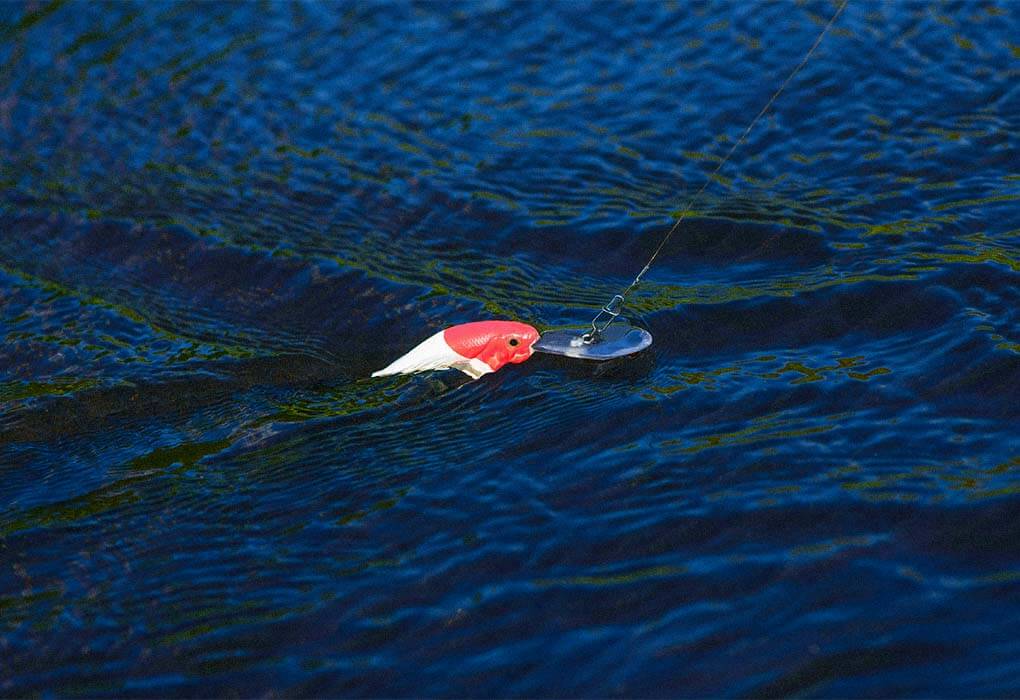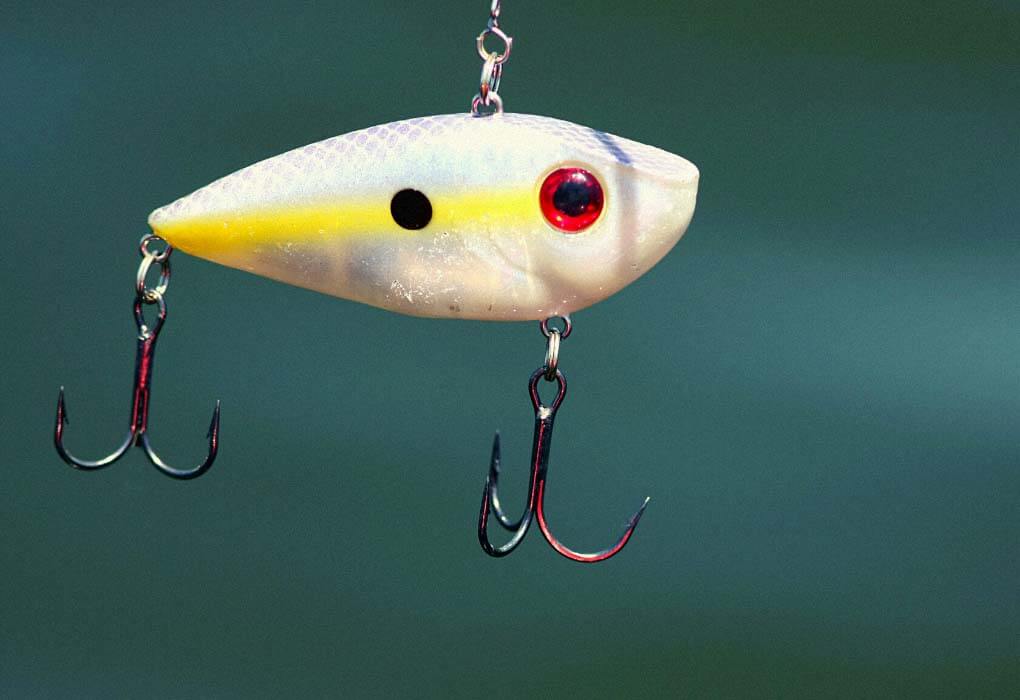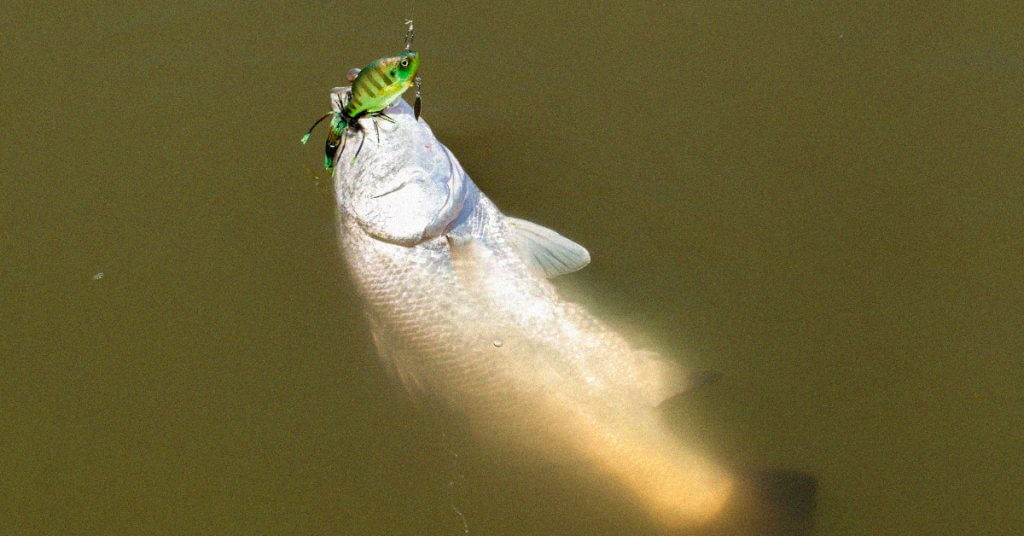Rigging and tying a crankbait doesn’t have to be complicated. Tie the main line to the split ring using your favorite knot. Make sure the crankbait is running straight by dragging it through the water, and get to fishing!
Fishing a crankbait is the quickest way I find bass. I love bass fishing with a crankbait just about anywhere I go, from ponds and lakes to rivers.
Through trial and error, I’ve learned how to rig a crankbait so I catch more bass.
Thankfully, it’s not difficult, and it’s guaranteed to catch bass in freshwater or saltwater.
How to Rig a Crankbait Step-By-Step
If you’re like me and prefer a Youtube video, you’re in luck! YBG Community Coordinator Wesley Littlefield breaks down rigging a crankbait for us!
Crankbaits are one of my favorite lures to throw because they’re simple to tie on and use.
Step 1: Crankbait Line Setup
Make sure your crankbait has a snap ring on the metal eye. Most crankbaits will come with it already attached, so you shouldn’t have to buy a snap ring.
Use your favorite knot to tie the 12-pound fluorocarbon line to the crankbait. I use a fisherman’s knot or Palomar knot. As long as it’s a quality knot, it will work.
Step 2: Test the Crankbait

I test my crankbait to ensure it’s running straight by dropping it in the water and pulling it with my rod. If it tries to turn too much on its side and skip across the water, I know I need to tune it before I cast it out.
To tune it, take a pair of pliers and barely bend the metal eye connected to the snap ring in the opposite direction the lure wants to turn. You may have to do this several times because it’s best to bend it in small increments.
Once I’ve got my lure running straight, I make a long cast to check its diving depth and ensure it reaches the bottom. As long as I feel it bumping off the bottom, I know it’s doing its job.
Now it’s time to begin fishing it.
Step 3: How to Fish Crankbaits
Knowing how to fish a crankbait is the key to catching more and bigger bass with this lure.
Crankbaits are designed to maintain contact with the bottom. That’s why a long cast is crucial.
The longer the cast, the more time the lure will bounce along the bottom of the water column in the strike zone, which means you’ll get more bites.
A slow-speed reel works well with crankbaits because you want to reel the lure as slowly as possible while still feeling the crankbait come in contact with the bottom.
Step 4: Know When to Use a Crankbait
As an inexperienced angler, I only wanted to throw a crankbait. I didn’t know there was a time and place for using crankbaits for bass.
When I learned the time of year and where to throw a crankbait, I began to catch more bass consistently.
During the spring, flat-sided and lipless crawfish-colored crankbaits work best because lipless crankbaits don’t wobble as much as a billed crankbait (which looks more natural in the cooler water), and crawdads are one of the primary food sources for bass during the time of year.
In late spring and early summer, when bass are in shallow water, a shallow diving bluegill-colored squarebill crankbait works best because bluegill are public enemy number one for bass guarding beds and fry during and after the spawn.
During the hottest time of the year, bass move to deeper, cooler water. This means deep-diving shad-colored or chartreuse crankbaits are the key.
If the water is clear, go with a natural shad or baitfish color, and if the water is murky or stained, go with a bright color.
During the fall, I switch back to shallow diving crankbaits in baitfish colors because the bass are bulking up for the winter.
Step 5: Know Where to Use a Crankbait
I used to spend a lot more time hung up or pulling weeds, and pond scum off of my crankbaits treble hooks because I didn’t know where to use a crankbait.
By picking up fishing tips from other bass anglers and testing them out myself, I realized the best places to throw these fishing lures are in rocky areas and along the edge of the grass.
The treble hooks are prone to get snagged if you try to fish a crankbait in the grass or a laydown like you would a jig.
With that said, I’ve gotten a lot of bites when running a crankbait over the top of a brush pile in deeper water or along the edge of a laydown.
Crankbait Setup
I’m a big believer in having the right tool for the job. If you’ve tried to work with the wrong tool, you know precisely why it’s essential.
With that said, I’ve fished using less-than-ideal crankbait fishing gear and caught loads of bass, so don’t feel you have to rush out and buy all new equipment.
Here’s what you’ll need:
- Crankbait rod
- Crankbait reel
- A spool of 12-pound test fluorocarbon fishing line
- Your favorite crankbait
Crankbait Rod

Different fishing rods have different strengths and bending actions to them.
A crankbait rod[1] has a softer rod tip (slow action) to help with casting and setting the hook, but it has a lot of backbone (Medium-heavy) for bringing the fish to you.
Crankbait rods are often made of fiberglass for strength and sensitivity.
Crankbait Reel
The reel is not as important as the rod. You’ll hear everyone has their favorite gear ratio or crankbait reel speed. I like a 6:1 gear ratio reel. However, 4:1 and 5:1 reels work well too.
I try to use as slow of a reel as possible to give me some strength to crank in the fish.
Sometimes I use a baitcaster, while I use a spinning reel other times.
The size of the crankbait determines the type of reel I use. For larger crankbaits, I use a baitcaster, and for smaller crankbaits, I use a spinning reel.
Crankbait Fishing Line
A 12-pound fluorocarbon line is what I recommend. Increasing the strength of the line can mess with the lure’s action, so I stay around a 12-pound test line for the most natural look.
Fluro sinks, so it won’t fight against the bait as monofilament or braid will, but I fished with mono for years with good success before I ever tried fluorocarbon.
Crankbaits

There are so many different crankbaits on the market today that it can be very overwhelming when trying to choose one to purchase.
Do you go with a shallow diving crankbait, lipless crankbait, or deep diving crankbait?
I recommend buying a shallow diving natural color and a shallow diving bright color to begin. As you add more to your fishing tackle box, you’ll want to purchase lipless and deep diving crankbaits and add more colors.
Many different brands make excellent crankbaits, such as Berkley, Rapala, and Strike King.
Frequently Asked Questions
Do you use a sinker with a crankbait?
No, you do not use a sinker with a crankbait. The sinker will negatively affect the action of the lure.
Do you put worms on crankbait?
No, you do not put worms on a crankbait. It will negatively affect the action of the lure.
One More Cast
Learning how to rig a crankbait properly will drastically increase the number of big bass you catch.
Crankbaits are excellent baits in several scenarios. I’ve caught largemouth and smallmouth while trolling, standing on the bank, and casting from a boat.
However, sometimes you’d be better off using different lures like spinnerbaits or a jerkbait or soft plastic rigs such as a Carolina rig, Texas rig, or drop shot.
My biggest largemouth bass with a crankbait is 6lbs; let me know what your PB is in the comments!





HY, MY NAME IS JIM, AND AS I HAVE NEVER FISHED WITH CRANKBAITS COULD YOU PLEASE GIVE ME A BIT OF IMFORMATION AS WHETHER I NEED ANY WEIGHT ON MY LINE WHEN I CAST OUT , AS THE MINI CRANKBAITS I HAVE BOUGHT FEEL VERY LIGHT. THANKS FOR ANY TIPS.
Hey Jim! No, you should not need to add a weight when fishing with a crankbait. The mini crankbaits are very light, so they’ll need a 4-6lb test fishing line to cast the best.
Thanks for reaching out! Hope this helps!